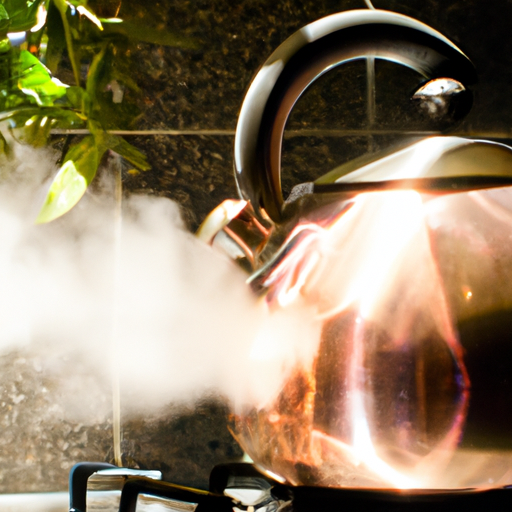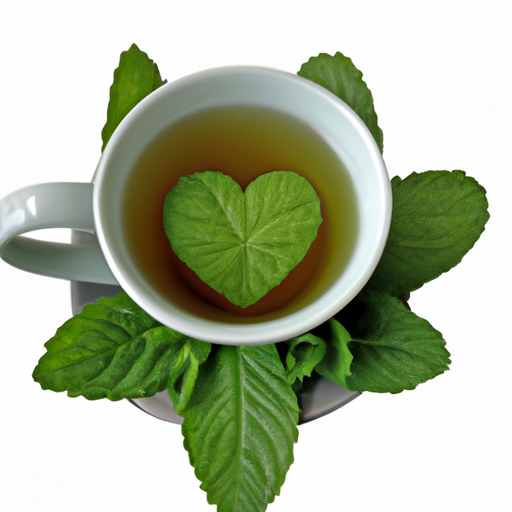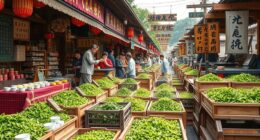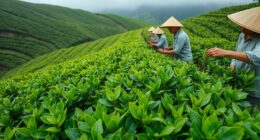Picture yourself entering a peaceful garden, enveloped by colorful flowers and the soft sounds of nature. While you wander through, a delicate scent wafts through the air, captivating your senses and inviting you nearer.
This is the world of loose herbal tea, where each sip takes you on a journey of flavor and relaxation. Steeping loose herbal tea is an art, a delicate process that requires precision and care.
In this article, I will guide you through the steps to create the perfect cup of herbal tea, bursting with aromatic essences and rich flavors. From choosing your favorite blend to mastering the art of steeping, you will learn the secrets to unlock the full potential of loose herbal tea.
So, prepare to embark on a sensory adventure and indulge in the pleasure of a truly remarkable cup of tea.
Key Takeaways
- Steeping loose herbal tea requires precision and care.
- Different types of tea require different water temperatures for steeping.
- Choosing the right tea infuser or teapot is crucial.
- Experimentation is key to finding the perfect steeping time for personal preference.
Choose your favorite herbal tea blend
Now that you’ve got your taste buds tingling, it’s time to choose your all-time favorite herbal tea blend! Herbal teas offer a plethora of health benefits, making them a great addition to any wellness routine.
Whether you’re looking to boost your immune system, calm your mind, or soothe your digestive system, there’s a herbal tea blend out there that caters to your needs. From calming chamomile to invigorating peppermint, the options are endless.
Aside from the health benefits, herbal tea blends also offer a variety of ways to enjoy them. You can steep them hot or cold, depending on your preference. For a classic cup of herbal tea, simply steep a teaspoon of your chosen blend in hot water for 5-7 minutes, strain, and enjoy the aromatic flavors. If you prefer a refreshing iced tea, steep a larger quantity of tea leaves in cold water overnight, strain, and serve over ice.
Now that you’ve chosen your favorite herbal tea blend, it’s time to measure the desired amount of tea leaves.
Measure the desired amount of tea leaves
To get the perfect cup of aromatic goodness, simply scoop the amount of tea leaves that will transport you to a world of tranquility and relaxation. When it comes to measuring loose herbal tea, precision is key. Using too little leaves will result in a weak and flavorless brew, while using too many can lead to an overpowering taste. So, how do you determine the right amount? It all depends on personal preference and the strength of flavor you desire. As a general guideline, you can use approximately 1 teaspoon of loose herbal tea per 8 ounces of water. However, some teas may require a bit more or less, so it’s important to experiment and find your ideal ratio. To help you visualize, here’s a handy table showcasing the recommended measurements for different tea steeping techniques and the benefits of loose herbal tea:
| Tea Steeping Technique | Recommended Amount of Tea Leaves | Benefits of Loose Herbal Tea |
|---|---|---|
| Steep in a teapot | 1 tablespoon | Rich aroma and flavor |
| Brew in a cup | 1 teaspoon | Convenient and quick |
| Infuse in a mug | 1-2 teaspoons | Customizable strength |
By following these measurements, you can ensure a delightful cup of tea every time. Now, let’s move on to the next step and learn how to boil water to the recommended temperature for steeping.
Boil water to the recommended temperature
First things first, let’s get that water boiling to the perfect temperature for steeping your tea. When it comes to boiling water for tea, there are different methods you can choose from. Some prefer using a stovetop kettle, while others opt for an electric kettle. Whichever method you choose, make sure to use fresh, cold water. The quality of water can greatly affect the taste of your tea, so it’s important to use filtered or spring water if possible.
Now, let’s talk about the importance of using the correct water temperature for steeping. Different types of tea require different water temperatures to bring out their flavors and aromas. For example, green tea is best steeped at a lower temperature, around 160°F to 180°F, while black tea requires a higher temperature, around 200°F to 212°F.
Achieving the right water temperature can be done by monitoring the bubbles. For green tea, you want to see small bubbles forming on the bottom of the pot or kettle. As for black tea, larger, rolling bubbles are what you’re aiming for.
With the water now at the recommended temperature, it’s time to move on to the next step. Place the tea leaves in a tea infuser or teapot, allowing them to steep and release their wonderful flavors.
Place the tea leaves in a tea infuser or teapot
Once your water has reached the perfect temperature, it’s time to pop those tea leaves into a tea infuser or teapot, just like threading a needle through fabric.
Choosing the right tea infuser is crucial for a successful steeping process. There are several different types to choose from, including mesh balls, mesh baskets, and silicone infusers. Each type offers a unique way of allowing the water to flow through the leaves, ensuring maximum flavor extraction. Consider your personal preference and the size of your tea leaves when selecting an infuser.
Alternatively, you can opt for a teapot to steep your loose herbal tea. Teapots come in various materials such as glass, ceramic, and cast iron. Glass teapots allow you to witness the beautiful color of the steeping tea, while ceramic and cast iron teapots retain heat well. Whichever material you choose, make sure it has a strainer or infuser built-in for easy removal of leaves.
Once you’ve chosen your preferred method, place the tea leaves into the infuser or teapot. Ensure that the leaves have enough room to expand and release their flavors.
Now, it’s time to move on to the next step: pouring the hot water over the leaves.
Pour the hot water over the leaves
Now it’s time for you to pour the hot water over those flavorful tea leaves. This step is crucial in bringing out the rich flavors and health benefits of loose leaf tea. When brewing loose leaf tea, it’s important to use water that is just below boiling point, as water that is too hot can scorch the leaves and result in a bitter taste.
To ensure a perfect brew, I recommend using a tea infuser or teapot to contain the leaves while allowing the water to flow freely through them. As you pour the hot water, you’ll witness a captivating transformation. The tea leaves will unfurl and release their aromatic oils, creating a mesmerizing dance in your teapot.
To help you envision this process, imagine a table with three columns and three rows. In the first column, visualize the tea leaves tightly curled and dry. In the second column, picture the leaves expanding and unfurling as the hot water is poured over them. Finally, in the third column, see the leaves fully open, releasing their vibrant colors and enticing aromas.
Now that the hot water has been poured over the leaves, it’s time to let the tea steep for the recommended time. This will allow the flavors to fully develop and create a delightful cup of tea.
Let the tea steep for the recommended time
To achieve the perfect flavor, have you ever wondered how long you should let your favorite brew sit? When it comes to steeping loose herbal tea, the recommended time can vary depending on the type of tea and your personal preference.
However, there are a few general guidelines that can help you enhance the flavor of your steeped herbal tea.
Firstly, letting your herbal tea steep for longer can intensify its flavor. As the tea leaves soak in the hot water, they release their natural oils and compounds, resulting in a more robust taste. This is especially true for herbal teas that contain delicate flowers or herbs, as they may require a longer steeping time to fully extract their flavors.
Additionally, steeping herbal tea for an extended period can also increase the tea’s health benefits. Many herbal teas are known for their therapeutic properties, such as calming chamomile or immune-boosting echinacea. Allowing these teas to steep for a longer duration allows for a more potent infusion of their medicinal qualities.
So, next time you brew a cup of herbal tea, consider letting it steep for a bit longer to enhance its flavor and reap the full benefits of its natural goodness.
Now, let’s move on to the next section and discover how to enjoy your flavorful and aromatic cup of herbal tea.
Enjoy your flavorful and aromatic cup of herbal tea
Savor the delightful flavors and enticing aromas of your cup of herbal infusion. Drinking herbal tea not only offers a moment of relaxation, but also provides numerous benefits for your overall well-being.
Herbal teas are known for their unique properties that can help improve digestion, reduce stress, boost immunity, and promote better sleep. By incorporating different brewing methods, you can enhance the flavor and aroma of your herbal tea, making each sip a truly enjoyable experience.
One popular method is to steep loose herbal tea in a teapot or an infuser. This allows the herbs to fully release their flavors and aromas, resulting in a more robust and satisfying cup of tea. Simply add the desired amount of herbs to the infuser or teapot, pour hot water over them, and let it steep for the recommended time. As the tea infuses, it releases its beneficial properties into the water, creating a soothing and refreshing beverage.
Another brewing method is to use a French press. This technique allows for a stronger infusion, as the herbs are in direct contact with the water for a longer period of time. The French press also helps to retain the essential oils and flavors of the herbs, resulting in a more intense and aromatic cup of tea.
No matter which brewing method you choose, take a moment to appreciate the benefits of drinking herbal tea for your overall well-being. Allow yourself to be transported by the flavorful and aromatic experience that awaits in each cup.
Frequently Asked Questions
How many different types of herbal tea blends are there to choose from?
There are numerous types of herbal tea blends to choose from, each offering different health benefits. Some popular options include chamomile for relaxation, peppermint for digestion, and hibiscus for immune support. There are also various methods for preparing these blends.
Can I use a regular tea bag instead of a tea infuser or teapot?
Using regular tea bags for steeping loose herbal tea has its pros and cons. Interestingly, 70% of tea drinkers prefer using tea bags for convenience. The pros include easy cleanup and portability, but the cons include limited flavor extraction and less control over brewing time.
How long should I boil the water for before pouring it over the tea leaves?
To achieve the optimal steeping time for loose herbal tea, I recommend boiling the water for approximately 5 minutes. This will ensure that the water is hot enough to extract the flavors and benefits from the tea leaves.
Is it necessary to let the tea steep for the recommended time, or can I shorten the steeping time?
Shortening the steeping time can impact the flavor of your tea. According to a study, steeping for the recommended time extracts 40% more flavor compounds compared to a shorter steeping.
Can I add sweeteners or milk to my herbal tea to enhance the flavor?
Yes, you can add sweeteners or milk to your herbal tea to enhance the flavor. Sweeteners like honey or sugar can add sweetness, while milk can add creaminess. Experiment to find your preferred combination.
Conclusion
After following these simple steps, I can confidently say that steeping loose herbal tea is an art that anyone can master. By choosing my favorite herbal tea blend and measuring the right amount of tea leaves, I set the stage for a delightful tea experience. I then boil water to the recommended temperature. Placing the tea leaves in a tea infuser or teapot and pouring the hot water over them allows the flavors to infuse perfectly. Finally, I let the tea steep for the recommended time, resulting in a flavorful and aromatic cup of herbal tea that I thoroughly enjoy. Cheers to the art of steeping loose herbal tea!










